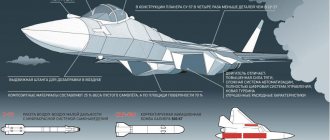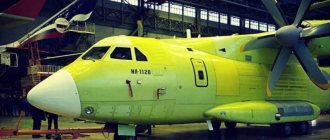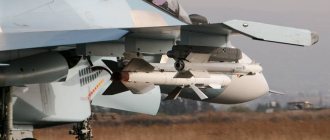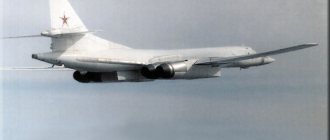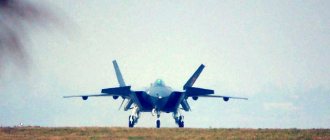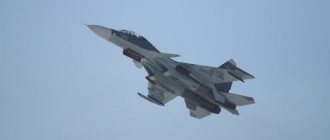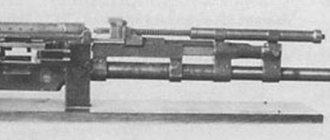In the mid-70s, the leading aviation powers began developing the concept of a fifth-generation aircraft. The main future requirements for the car were developed, and the appearance was designed.
At the time when the fourth generation aircraft were just being tested or entering service, the basic requirements of the future fighter were already ready.
What is included in the concept of “fifth generation aircraft”?
We will not list all aspects of the “fifth generation” concept. Much has been written and said on this topic. Let's focus only on the basic requirements.
- Reduced visibility in all radiation ranges.
- Multifunctionality.
- Transition to passive equipment.
- Non-afterburning supersonic flight mode.
- Increased maneuverability due to aerodynamics and the use of controlled engine thrust vectoring.
- Automation of combat influence on the enemy in all flight modes.
These are, in brief, the main modern requirements for promising combat systems.
Russia and the United States had different approaches to the development of a new generation of aircraft. So, in Russia, they place the main emphasis on super-maneuverability. While the Americans relied on stealth and the aircraft being equipped with modern combat systems. According to American experts, the latest weapons developments will allow the aircraft not to enter the phase of close visual maneuvering combat. Win the battle thanks to a more powerful radar and stealth at medium distances.
The global arms race and improvement of both military and civilian technologies will lead the whole world to progress and achieve new goals. This is the case with airplanes; they are constantly undergoing modernization and improvements, which will allow them to meet global requirements. Having analyzed the aircraft industry over the past hundred years, we can conclude that in a fairly short historical period of time, humanity in the early stages managed to take off from the ground and make its first small flights, and at the moment new aircraft can very quickly cross distances over continents and oceans. Due to all this, humanity and the aircraft industry have come to the creation of 5th generation aircraft.
PAK FA T-50 read more…
The first aircraft, which belong to the 5th generation, were created back in 2001 in the USA, and in our country at that time the flight testing phase of the aircraft of this line was ending. The first developments to create a 5th generation aircraft began back in the 70s of the last century. Moreover, the development of these projects was started in parallel both in the USA and in the USSR. An interesting fact is that at this time the 4th generation machines made only their first flights, and the government and designers planned to create even more advanced machines. To create a project and develop qualitatively new machines, the best designers from advanced design bureaus and research centers were assembled.
F-35 read more…
In reality, at the moment, many countries around the world are developing such aircraft; the greatest achievements have been achieved by countries such as the USA with its F-35, Russia and its PAK FA, China with two models J-31 and J-20, as well as Japan with the Mitsubishi aircraft ATD-X. As for combat use, fifth-generation aircraft have been put into service only in the United States since 2014. This representative is designated F-22.
Su-57
Many people call the Su-57 by its factory code T-50 or by the name of the program - PAK FA. After passing the first stage of state tests, it will continue to be refined, while at the same time beginning full-fledged official use. In addition, special recommendations will be created for designers and personnel.
Su-57 (photo: Lebedev Sergey)
Ten Su-57 prototypes are currently flying. Plans for 2022 include ordering the first production batch of a dozen vehicles. From 2022, they will be immediately sent to the troops.
How are things going with new products abroad?
Development of PAK-FA
Work on the PAK FA began in 2002 within the walls of the Sukhoi Design Bureau. Having had an unsuccessful experience working on the Su-47, the design bureau planned to carry out detailed work on the errors. The new machine received the serial number T-50 and already in 2004 the first mock-up of the aircraft was demonstrated, which was approved, financing of the project and large-scale work on its implementation began. The first flight prototype took to the skies in 2011. In the summer of 2022, the newest fighter finally received its official name - Su-57. Today, a number of problems remain unresolved with engines and the development of new weapons, which should be fundamentally different from the currently available R-73 missiles, as well as weapons for hitting various targets. So far, the Su-57’s weapons and its features remain a matter of speculation.
F-22 (USA)
The pride of the American aviation industry, as well as film and game makers.
This is the only fully developed fifth-generation fighter in the world, significantly superior to its predecessors in all characteristics.
Increased cruising speed and flight altitude, low visibility and a powerful radar with a set of passive detection means give the F-22 significant superiority in long-range missile combat.
F-22A Raptor (photo: Rob Tabor)
Of course, this is not an ideal fighter - it still has not been equipped with a helmet-mounted sight, there is no optical-location station, and the shallow weapons compartments limit the choice of weapons for “work on the ground.”
It was produced until the end of 2011. A total of 195 units were produced, including prototypes. Then they wanted to resume development, but considered it inappropriate. Export was banned by a separate law - secrecy!
The F-22 was the only fighter mentioned in the article that took part in combat - in recent years it has occasionally bombed in Syria and Afghanistan.
F-35 (USA)
The most scandalous creation of the American military industry. He can boast that he has many more haters on the RuNet than Elon Musk - and this is not easy! In general, an understandable attitude towards the world’s most expensive military program of our time.
The F-35 challenges the sense of beauty and the idea of what a fighter should actually be. Critics blame it for its prohibitive cost and endless hardware problems. In addition, many of the declared technologies have not yet gone beyond the boundaries of laboratories, while the aircraft itself is already in full production.
F-35A Lightning II (photo: US Air Force)
It was produced in significantly larger quantities than the F-22. At the end of last year, more than 265 machines were already delivered to customers. And it would be nice for us to get the same number of Su-57s by the end of the next decade!
In 2022, it is planned to commission another 90, and from next year we will begin producing more than a hundred per year.
In addition to the United States, eight partner countries are involved in the creation of the aircraft. Three more purchased it through export.
At the moment, the flight and technical personnel are being trained and the vehicle is being finalized, but the US Air Force and Marine Corps have already announced initial operational readiness.
In addition to the States, F-35s fly in Norway, Italy, Israel and Japan.
J-20 (China)
Asian Dragon, another newcomer.
At first, foreign experts stated (and then Chinese state media confirmed) that the new fighter was already being actively used not only in training and testing centers, but also in combat units. It is known to be stationed in the southeastern part of the country, near the South China Sea, full of disputed islands (and foreign warships).
The appearance of a number of elements of the aircraft evoked associations in domestic patriotic circles with the MiG 1.44, an unrealized Soviet fifth-generation fighter project. However, in American circles it evoked the same associations, but with the F-22.
J-20 (photo: Ruimin YAN)
It’s simple - the Chinese carefully studied the entire world experience, and the “similarity” appeared primarily due to similar requirements. By the way, at the first demonstration of the PAK FA in the American aviation community, there was an opinion that “the damned Russians stole our YF-23.”
If everything is complicated with the origin of the J-20, then the Chinese seem to have taken the American method as an approach to development (it is now being implemented on the F-35).
We mass produce an obviously “crude” vehicle, and then master it among the troops, train the personnel and immediately catch the “bugs.”
The J-20 flew a year later than the Su-57, in 2011. But the plane is clearly still unfinished - it flies on our engines from the Su-27, and is only undergoing tests with Chinese engines.
In the coming years they promise to launch a radically modified version of the J-20B.
Basic global requirements for a 5th generation aircraft
First of all, new devices must have significantly better flight performance and combat characteristics. It is for this reason that the characteristics that the new combat aircraft must meet were developed.
- Minimize the visibility of the aircraft to radar towers and infrared detectors with a passive or covert method of operation of the aircraft’s onboard sensors;
- Increased versatility, which allows the vehicle to be used for a wider range of combat missions. This should ensure effective combat against both air, surface and ground enemy targets.
- The aircraft must have a circular information system, which allows you to control all the movement of objects around the aircraft. Not long ago, a helmet was created for these aircraft, which allows the pilot to look through the aircraft in any direction.
- Speed indicators that the aircraft must meet have also been established. Thus, 5th generation aircraft must reach supersonic speeds without using afterburner.
- High indicators of super-maneuverability of the device.
- New generation aircraft should be able to fire multi-channel missiles from a long distance, as well as fire at enemies from all angles in close combat.
- The control of on-board information equipment and the new jamming system should be carried out automatically.
- The vehicle must be controlled by just one combat pilot, who must work with a tactical situation indicator, which displays information from all external sensors, and this information is pre-processed by computer programs by comparing, scaling and overlaying information.
- The entire design and aerodynamics of an aircraft of this type must provide the ability to very quickly change the trajectory without delay. Moreover, the execution of turns and bends should not require very precise coordination of the controls.
- For effective operation and combat use, the aircraft must forgive the pilot even gross control errors over a fairly wide range.
- Also, the automation of a 5th generation aircraft is required to independently solve tactical problems and have a so-called “Pilot Assistance” program.
J-20 read more…
There are differences in the priority areas for the development of aircraft of this generation in different countries. The current requirement for an aircraft manufactured in the Russian Federation was super-maneuverability, which was supposed to ensure maximum stability of the aircraft at various angles of attack. Also, the new aircraft must withstand high overload rates. Much attention was paid to the development of military weapons that could ensure maximum combat effectiveness when the target is outside the trajectory vector. It should be noted that almost the same requirements were put forward for the American 5th generation projects, but they soon set other priority goals that the aircraft must meet to the maximum.
Mitsubishi ATD-X read more…
So, American designers chose to pay special attention to the dynamics of the entire car. The Americans abandoned the previously planned path due to the fact that new highly maneuverable missiles were created that could carry out an attack from any angle. The new missiles are equipped with homing heads, which makes it possible to carry out an attack not only from a position behind the enemy’s rear hemisphere. Due to all this, it was planned to conduct air battles at medium ranges, and in special situations it was possible to switch to close combat. These aircraft and their equipment to reduce the visibility of the vehicle transferred air battles to the “first to see, first to shoot down” category. On the one hand, the logic of the Americans and their priorities is clear, but the meeting of two similar vehicles with a similar set of equipment will lead to the return of older combat tactics, and then maneuverability will be very useful.
FC-31 (China)
The second Chinese fighter is conventionally “light”, although also twin-engine.
Here the source of inspiration is simpler - the FC-31 is clearly a child of incest between the F-22 and F-35. They definitely did this deliberately: one of the main goals was to create a competitor in the global market for the F-35. That is, cheaper, without strict requirements for buyers and preferably close in capabilities.
Even at air shows, the model was shown in a coloring that so clearly copied the American that it looked like a complete mockery.
However, the program clearly has limited government support. It is unclear whether China itself will purchase this car. Although the FC-31 flew just a year after the J-20, only a couple of prototypes using Russian engines (this time from the MiG-29) are still in testing.
FC-31
Probably, success now depends on whether the manufacturer will be able to find buyers for large quantities or interest his own government.
"T-50": crew
How many people does it take to pilot 5th generation aircraft? The crew of this model is incredibly small: it consists solely of one pilot. However, it is not surprising that a pilot will have to undergo extensive training before being able to fly such a fighter. With fifth-generation aircraft taking automation to new levels, many might think that pilot requirements will decrease. But they are only increasing, because now he will need to be able to interact with all modern systems. But it is much more interesting to find out what weapons the 5th generation combat aircraft that the Russian Federation is going to produce will have on board.
X-2 (Japan)
Since sworn friends the Chinese became seriously interested in aviation, the Japanese also did not stand aside.
In the Land of the Rising Sun, the aviation industry and the military-industrial complex (military-industrial complex) are very closed and specific, but very developed.
In the spring of 2016, the Japanese released an aircraft that the press immediately called the prototype of a new generation fighter, but this was a clear exaggeration.
The X-2 is more of a flying laboratory and technology demonstrator. They want to test technical solutions there and gain the necessary experience - for example, work with controlled thrust vectoring.
X-2
This machine will not go into production directly and after testing is completed it will go to some museum. Whether the Japanese will develop a new promising fighter is still unknown. However, against the backdrop of general militarization, the situation may well change soon.
KF-X (South Korea)
There are a lot of Asians on this list. What to do, since old Europe has become decrepit and cannot keep up the pace of the arms race. So the Koreans are not going to lag behind the Chinese and Japanese. Their plans are quite specific - they are already planning to begin deliveries in the middle of the next decade.
True, so far they can only boast of mock-ups.
KF-X
The makings, by the way, are not bad. The Koreans have already found a partner and a promising large buyer - Indonesia. In addition to financial support, there is also moral support - from senior American comrades who are involved in the development.
With the naked eye you can see the influence of the same F-22 and F-35. It is possible that the Americans are planning to help the Koreans make a competitor for the Chinese FC-31 and receive a certain percentage of sales. But, since it is impossible to simultaneously create a competitor for the F-35 (which is being bought by Korea), this fighter will be simpler for customers.
The sixth generation for the US Air Force: how it is portrayed and what it will be like in reality
Everyone will get it
The Next Generation Air Dominance (NGAD) program has a rather complicated and long history.
It is usually associated with the US Air Force, but the US Navy is working on a program with the same name. However, they differ in terms of requirements, and the sixth generation naval fighter itself has the symbol F/A-XX. Be that as it may, they are more often talking about the rearmament of the Air Force, which, as it has become known, will face a reduction in the types of aircraft used. Of all its fighters, the Air Force wants to keep only the F-35, F-15 and F-16. The place of the F-22, which will be retired in the foreseeable future, will be taken by Next Generation Air Dominance.
This is, of course, a symbolic designation.
Moreover, it is now impossible to say for sure whether the machine will be manned or unmanned. Its characteristics are kept secret, and the only evidence of NGAD's progress was the US Air Force's announcement last year of testing a " full-scale demonstrator
" that "
broke many records
." At the same time, the Air Force expressed maximum readiness to create a promising fighter.
Northrop Grumman concept
There are more and more official (with some conventions) images of the promising aircraft, and, it must be said, they raise many questions. Recently, aviation enthusiasts were actively discussing a video from Northrop Grumman Corporation, one of the leading US defense companies that once created the B-2 bomber and is now working on its successor in the form of the B-21 Raider.
Northrop Grumman showed a video of a hangar where aircraft are parked.
In the foreground on the left is a concept of an extremely large stealth fighter without a vertical tail and with air intakes located at the top (we only see one of them in the image). It's difficult to say what exactly Northrop Grumman showed. However, the most logical assumption (taking into account the recent Air Force statement about testing a sixth-generation fighter) seems to be that this is Next Generation Air Dominance. The aircraft shown was compared to the experimental Scaled Composites Model 401 winged aircraft, which was created by Scaled Composites, a subsidiary of Northrop Grumman. Its air intake is located on top behind the cabin, and in the central part of the fuselage there are compartments for placing equipment.
However, it is too early to rush to conclusions. Although we do not know who exactly is working on the “six” for the Air Force, everything does not speak in favor of Northrop Grumman. As noted above, the company is currently busy developing the B-21. In addition, its competitor Lockheed Martin has much more experience in developing stealth fighters: it created the F-22 and F-35.
“Lockheed Martin's chief financial officer has hinted that the aerospace giant is working on a new aircraft program—and clues suggest it could be the Air Force's secret new fighter jet,” Popular Mechanics wrote last year
.
As presented by the US Air Force
The US Air Force itself is adding fuel to the fire. The Air Force showed another vision of what a promising sixth-generation fighter might be in the spring of 2021. The manned vehicle received two engines and a vertical tail. The air intakes, notably, are on top, like the Northrop Grumman concept.
Another stealth fighter (albeit with a more “traditional” arrangement of air intakes) was shown last year in a material dedicated to the 73rd anniversary of the US Air Force. The plane has a triangular shape and is vaguely similar to images of the semi-mythical Aurora that can be found on the Internet.
The most notable thing here seems to be the presence of a pilot. It is no secret that many consider the sixth generation fighter to be a UAV. At the same time, it cannot be ruled out that Next Generation Air Dominance will be an optionally manned aircraft.
Real appearance
Earlier this year, a model of an unknown aircraft, which some identified as an NGAD, was discovered at a Lockheed Martin facility near the headquarters of its Skunk Works division.
If this is indeed the case, the aircraft is very similar to the Six concepts that have been seen online for years, particularly Boeing's minimalist concept.
An aircraft devoid of vertical tails better fits the stealth requirements, but at the same time this can affect the controllability and maneuverability of the aircraft. The latter, one must assume, is no longer as significant as it used to be. Due to the development of missile weapons.
But is the appearance of the aircraft itself so important?
Gazeta.ru quotes Rick Wormold, a research fellow at the Center for Defense and Foreign Policy Studies at the City University of New York:
“NGAD is no longer an airplane. The fighter is only part of the system. The future war in the air will involve the sharing of advanced networks and interconnected families of various types of devices.”
According to him, the Next Generation Air Dominance pilot may not be needed at all. However, it must be remembered that along with the development of UAVs, the means to combat them also progress. And judging by the concepts that we have seen, the creators of the sixth generation do not plan to completely abandon the pilot.
"Six" for the Navy
This fall we witnessed another sixth-generation concept, which, however, no longer concerned the Air Force, but the US Navy. The word “concept” in this case sounds even too loud. In fact, this is just an image in which you can only see the general outline of the fighter.
The aircraft was featured in a document titled “Navy Aviation Vision, 2030-2035.”
The fighter has a very original wing design and front horizontal tail. There is also probably a V-shaped tail (it's quite difficult to tell from the image). In any case, the car is very different from how the F/A-XX was shown before. Let us recall that Boeing’s early concept was designed according to the “tailless” design: it was reported that they wanted to see the aircraft in manned and unmanned versions. In its 2013 appearance, the fighter had a front horizontal tail and was deprived of a vertical one.
Why did such metamorphoses occur? Perhaps the creators decided to choose a more “classical” layout. Something similar happened in the 90s, when the more traditional Lockheed YF-22 was preferred to the Northrop/McDonnell Douglas YF-23. In any case, we will almost certainly be able to see a sixth-generation demonstrator in the coming years, after which many questions will automatically disappear. Whether it will be a device for the Air Force or the US Navy is not so important.
Subscribe to our Telegram channel, daily additional materials, what is not included on the site: https://t.me/topwar_ru
AMCA (India)
As part of the FGFA program, the Indians have long planned to jointly develop with us an export version of the PAK FA. However, recently the project has been seriously stalling, obviously on the Indian side - they are either bargaining or even thinking about stopping work.
At the same time, one cannot help but recall the national program for the development of the promising AMCA fighter. Previously, it was planned to do it in parallel with the Russian-Indian FGFA - also with our help. However, the Indians can also find other partners - for example, those who will be very happy if they buy the F-35 instead of the Su-57.
AMCA
AMCA's first flight is planned for the middle of the next decade.
But India's ability to create a combat aircraft, even the simplest one, raises serious doubts.
The Tejas epic demonstrates that in more than thirty years they have only been able to do something at the level of the modernized MiG-21.
Checkmate for the US aviation industry: Russian fighter Checkmate goes into production
The fifth-generation fighter Checkmate (“Checkmate”) became a sensation at the MAKS-2021 air show in July of this year. It was shown to the general public quite suddenly: no leaks about the development of this machine had previously appeared in the media. And now, only four months passed from the first photos to the launch of serial assembly, an absolute record for Russia!
The first information about the unique aircraft appeared in open sources literally a couple of days before the presentation, when “good people” photographed a full-size mock-up of the fighter - first covered with fabric, and then installed in the pavilion.
And now the real production of these fighters has started. The assembly of the aircraft began by specialists from the aircraft plant named after Yu.A. Gagarin in Komsomolsk-on-Amur.
Universal Soldier
The presentation of the new machine was held in style, at the highest level, thanks to which Checkmate largely eclipsed other exhibitors - including the MS-21 civilian airliner, ready for production, and unmanned helicopters, and many other interesting products of the aviation industry. Not only the Russian and American press rushed to discuss the novelty (which was completely natural), but also Chinese, Indian, and Vietnamese publications.
The fighter impressed the public not only with its advanced design, but also with its declared characteristics.
New fifth-generation fighter Checkmate. Photo: Rostec State Corporation
Firstly , the Rostec State Corporation reported that Checkmate will be an aircraft with an open architecture, that is, it is only a platform on which electronics and weapons systems from various manufacturers and different standards can be installed. Thanks to this, the vehicle should become a “universal soldier” in the air war of the future. In the fighter version, Checkmate will fight to seize air supremacy, and, having changed equipment, will carry out strike missions against enemy ground and surface targets.
Secondly , the aircraft fully complies with the criteria of the fifth generation: an airframe made using stealth technology (both in contours and in the composite materials used); weapons located in the internal compartments, radar with an active phased array antenna (AFAR), supersonic cruising flight speed without switching the engine to afterburner mode. Moreover, Checkmate can be turned into a drone. In relation to fighters, this is already a feature not of the fifth, but of the sixth generation. That is, in all respects this aircraft promises to become advanced.
According to the manufacturers' calculations, it will be able to accelerate to Mach 2 (Mach 1 is the speed of sound, approximately from 290 to 330 m/s, depending on altitude) and carry up to 7.4 tons of payload over a range of up to 2800 km. What do these numbers say? Almost seven and a half tons of bombs and missiles are an indicator, although smaller, but still comparable to the payload of the American all-weather fighter F-15, a heavier class vehicle. Two speeds of sound is quite an ordinary achievement for aircraft of the third generation of jet aircraft, but even for representatives of the fifth generation this is a very, very good level. Checkmate should be twice as fast as the American F-35 Lightning fighter-bomber and equal in speed to the “golden” F-22 Raptor, a multi-role fighter from the flagship of the American defense industry Lockheed Martin.
And taking into account the fact that the export of the latter is prohibited, the third thing : the Russian “chess player” simply has no competitors on the international market. By the way, it’s worth talking about the market in more detail.
Initiative fighter
The Russian vehicle was not developed by order of the Ministry of Defense, but on its own initiative. This is a very important detail. Firstly, it means that the developers did not use budget money, but corporate money. One could say that they created the aircraft “on their own”, as far as this definition is applicable to a state corporation. In addition, the developers were based not on the requests of the military, but on the current requirements of the market.
The idea was born from economics. In our opinion, there are now a lot of single-engine aircraft on the market... But there is no fifth-generation single-engine aircraft at an acceptable, economically feasible price that would be affordable for most customers of military multirole aircraft,
- General Director of the United Aircraft Corporation (UAC) Yuri Slyusar .
As a result, the developers have created a fighter that has everything that people on the international market are willing to pay money for.
Obviously, another point of support for Checkmate is the huge scientific and technical reserve accumulated during the creation of the Su-57. The planes are not just similar in appearance: Checkmate, in fact, is a single-engine version of the “fifty-seventh”, maximally adapted to the requirements of foreign customers. The development program for the advanced front-line aviation complex (PAK FA), which later became the Su-57, was carried out with the active participation of India. According to open sources, New Delhi has invested $6 billion in the program since 2007, covering 35% of the costs of research and development (R&D) and testing.
Promotional video for the fifth-generation fighter Checkmate, timed to coincide with the premiere display of the aircraft at the Dubai Airshow 2022. Source: Rostec Corporation
However, in 2018, India withdrew from the project, preferring to purchase French Rafale fighters. This deal had some signs of a large-scale corruption crime (at least some Indian politicians are convinced of this) and is worthy of a separate article; Let us note here that the French aircraft manufacturing company Dassault Aviation sells fighter jets to the Indians at an absolutely astronomical price tag: 208 million euros apiece. As a result, the 7.5 billion euros (60,000 crore rupees; in a crore - 10 million rupees) allocated for the rearmament of the Indian Air Force is enough to purchase not a hundred fighters, but only 36.
In 2022, Indian pilots had to fight Pakistani F-16s and JF-17s using obsolete, although modernized, MiG-21s. Having received not the most pleasant impressions from the week-long conflict, the Air Force leadership urgently demanded the purchase of 12 Su-30MKI fighters and 21 MiG-29.
Against this background, Rostec rolled out a fighter whose name simply screams about its connection with India, the birthplace of the smartest game in the history of mankind. In fact, Checkmate combines everything that is dear to the heart of the Indian Air Force: supersonic flight in non-afterburning mode (the lack of such was one of the main officially stated reasons for India’s withdrawal from the PAK FA program), stealth technologies, open architecture that will allow it to be used like Russian , both Western weapons and versatility on the battlefield. However, the creation of these “goodies” was already largely paid for by Indian taxpayers.
One engine is good, two are many
Since the late 60s of the last century, militaries on both sides of the ocean began to come to the understanding that Air Force fleets should include both single- and twin-engine aircraft. The latter have a longer flight range and payload, and have greater survivability. However, single-engine fighters are absolutely necessary to perform many routine missions in a limited theater of operations for which the use of twin-engine machines is redundant.
In tactical terms, single-engine vehicles feel more confident in maneuverable battles, so-called dogfights. But their main advantage lies in the economic plane. An aircraft with one engine requires half as many consumables, maintenance work and spare parts as its twin-engine counterpart. Modernization and remotorization of a fleet of such fighters is also several times cheaper than twin-engine ones. At the turn of the 19th and 20th centuries, an aphorism was born: if you want to ruin a small country, give it a cruiser. Over the past half century, combat aviation has coped with this task very well.
Classic examples of such complementary pairs are the American single-engine F-16 and twin-engine F-15, as well as the F-35 and F-22. Super-successful single-engine fighters include the Swedish Saab JAS 39 Gripen, the Soviet MiG-21 and its numerous Chinese clones.
The USSR turned away from the path of creating a mixed fleet of single- and twin-engine fighters in the late 1970s, when the Mikoyan Design Bureau created the twin-engine MiG-29 under the light advanced front-line fighter (LPFI) program. The vehicle turned out to be very thrust-armed, and therefore incredibly maneuverable. The Soviet Union did not spare money on defense, and at times did not even count it, so operating costs did not bother anyone. And it cannot even be said that the 29s did not fit into the market: at different times they were purchased by India, Egypt, Malaysia and Myanmar, Eritrea and even Peru. However, time passes, and the attractiveness of these aircraft is gradually decreasing.
Alas, at the end of this technological revolution it turned out that Russia simply physically does not have a light single-engine fighter. The last successful representative of this class was the MiG-21, but the MiG-23 was neither simple nor light, and has now become a relic of the Cold War, in service only with the air forces of Kazakhstan, India and Sri Lanka.
Blow up the market
The head of Rostec, Sergei Chemezov, reported that Checkmate would cost customers $25–30 million apiece – almost an order of magnitude cheaper than Rafales. Other figures for comparison: you (if you are not under sanctions) can buy the American F-16D Block 52 for $34 million, the more advanced Su-30 for 50 million inside Russia and for $83 million if you are a foreigner. And most importantly, the American F-35 Lightning, the closest analogue of Checkmate, just recently dropped in price to $77 million. It is obvious that Checkmate will become a very unpleasant competitor for the F-35.
Checkmate fighter. Photo: PJSC UAC / globallookpress
Why does such a machine, which is outstanding in terms of its stated characteristics, have such a low price? Apparently, the fact is that Checkmate was created on the basis of the Su-57, and as you know, R&D costs make up a very significant share of the cost of each new fighter. When selling finished machines, the manufacturer must not only recoup the cost of production and make a profit, but also return the funds spent over 10–15 years of work by qualified teams, dozens of experiments, construction of experimental samples and research ordered from related companies.
Another factor that significantly reduced the cost of the machine was that the Checkmate was created using a supercomputer. This approach not only accelerated development, but also eliminated many expensive full-scale tests. However, no modeling would be possible if the developers did not have extensive databases obtained from previous research. And the development of this data was precisely ensured by the program for creating the Su-57.
So what?
And then there are problems.
Let's not lie to ourselves: no matter how strong Russian technical developments are, the weakest feature of our military-industrial complex is the timing of the introduction of developed products.
Frigates in Russia have been under construction for as long as Chinese aircraft carriers.
UAVs do not leave the stage of flying prototypes and pre-production samples for ten years.
Even the production of modern armored vehicles is constantly stalling.
If Rostec and Sukhoi manage to meet the stated deadlines and begin serial production of Checkmate within five years, this achievement will be no less, and rather even more significant, than the development of the aircraft itself.
Ending the bad tradition of long-term military construction and many years of delays is an absolutely necessary condition for success in modern conditions for both the army and the military-industrial complex.
